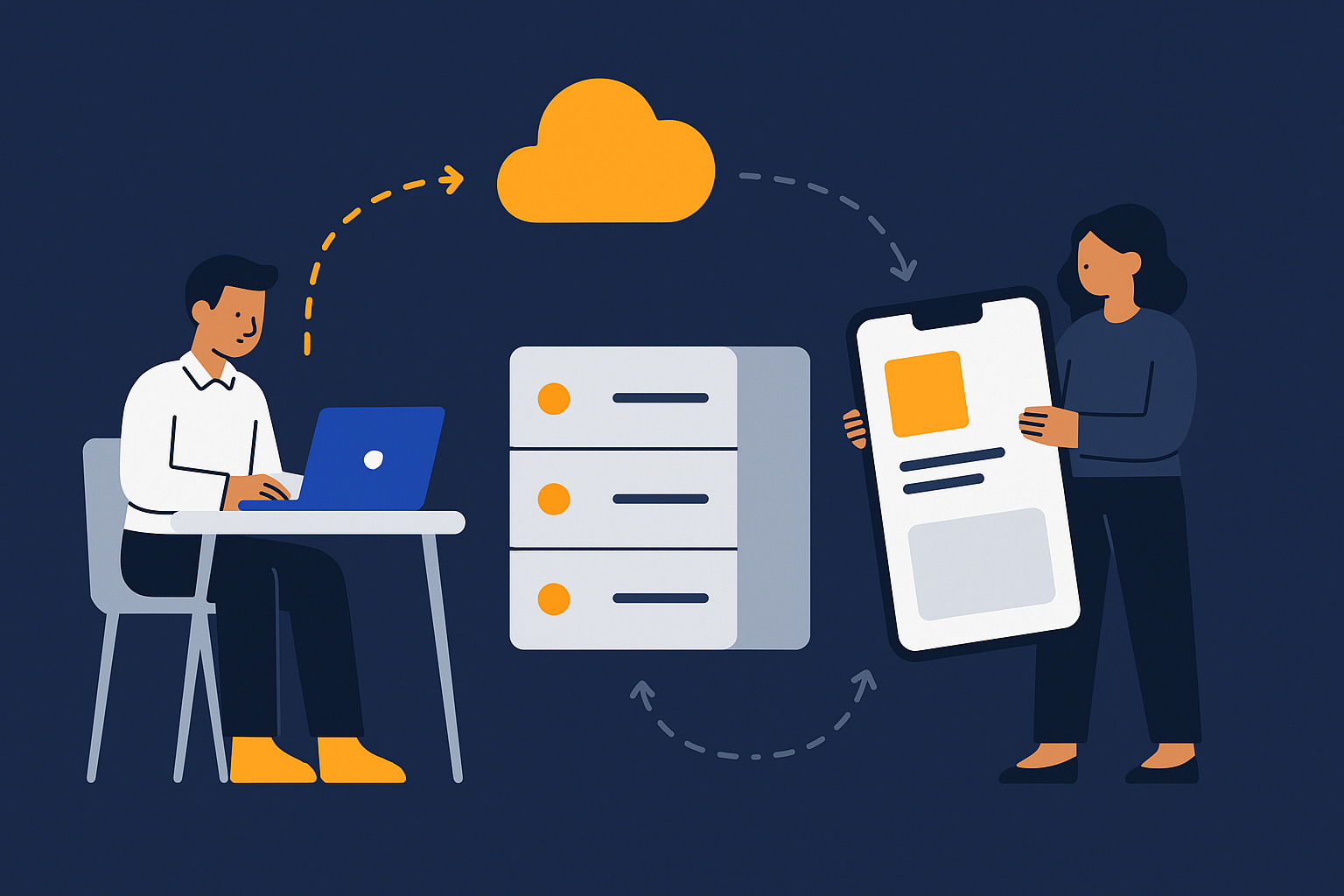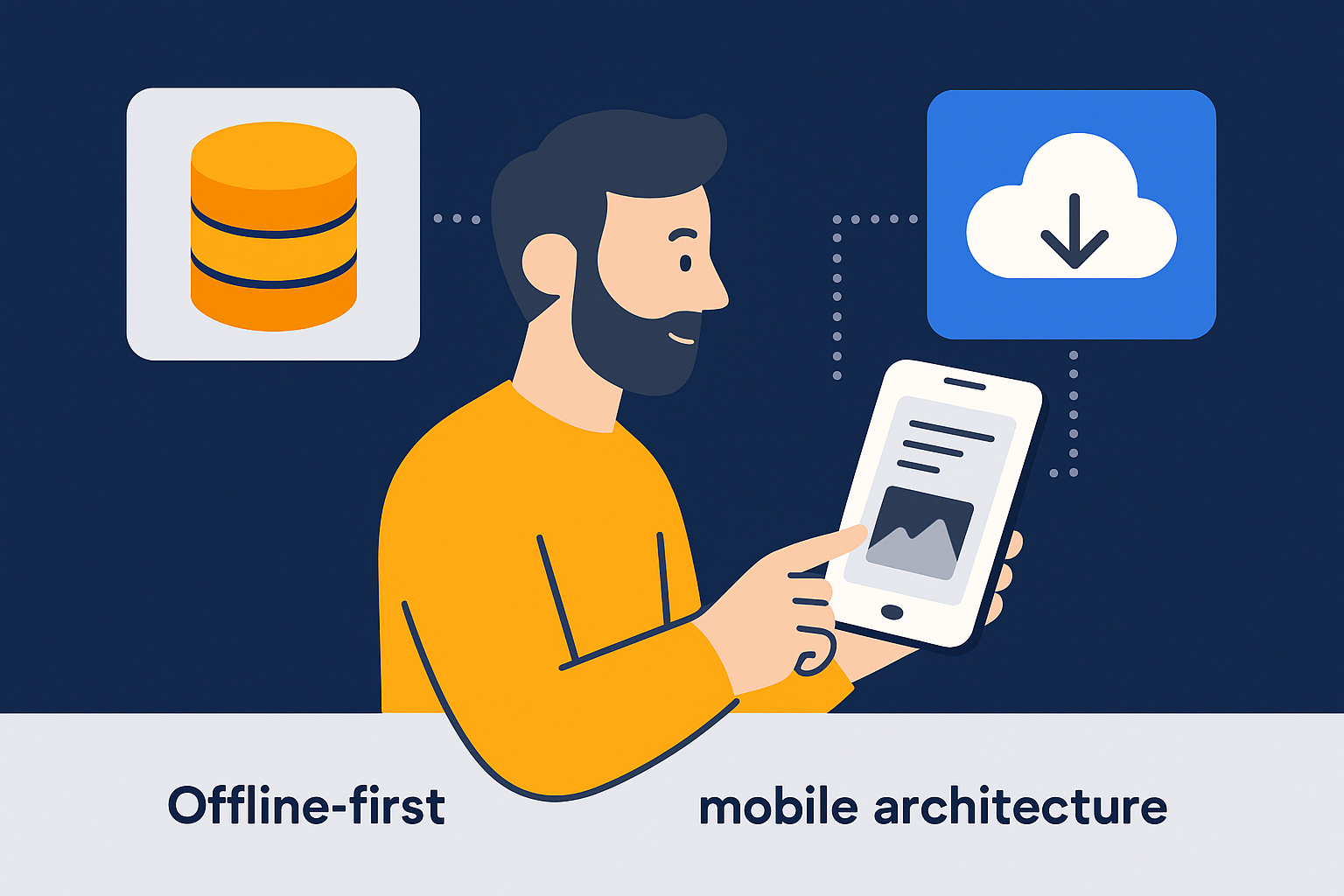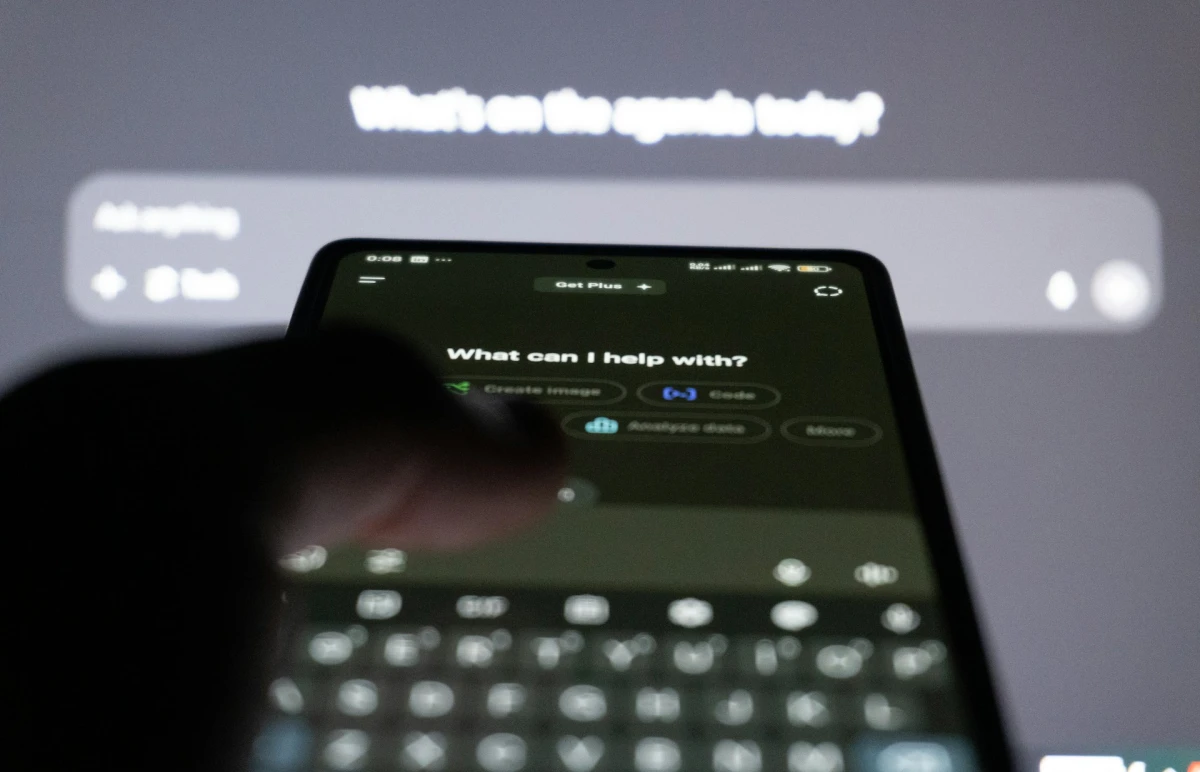Introduction
Field operations, frontline sales, and on‑site service teams often work where connectivity is intermittent or expensive. The standard “always‑on” assumption breaks down in mines, factories, hospitals, ships, and rural areas—precisely where enterprise platforms are asked to deliver critical workflows. When your mobile application is instrumental to revenue capture or safety compliance, a loading spinner is more than a nuisance—it’s a business risk.
Offline‑first enterprise mobile architecture turns that risk into a strategic advantage. By designing for disruption from the start, organizations can deliver consistent experiences, maintain data integrity, and keep teams productive regardless of network conditions. In this article, CoreLine shares a practical, engineering‑driven blueprint to plan, build, and scale offline‑capable applications—from MVP development services through enterprise‑grade rollout—without compromising security, compliance, or total cost of ownership.
Whether you are a CTO aligning architecture with regulatory obligations, a product manager prioritizing a roadmap, or a founder validating market fit, this guide outlines the decisions that matter and the trade‑offs to anticipate. It also invites you to a live session where we’ll go hands‑on with patterns and tools that have worked in the field.

What “offline‑first” really means for enterprises
A common misconception is that offline support equals “cache data locally and sync later.” In enterprise application development, offline‑first is a product and systems strategy with four properties:
- Durable local state: A complete, secure local model enabling core workflows without connectivity.
- Deterministic sync: Clearly defined rules for changes, conflict resolution, and retries—observable and testable.
- User‑aware UX: Explicit states and guidance so users know what the system is doing, what’s safe to do, and what will happen next.
- Governance and compliance: Data retention, audit trails, and access controls that hold up under security review even when devices are out of network.
This mindset reduces rework later, especially when your MVP needs to scale across regions and teams. By aligning an offline‑first approach with your roadmap from day one, you avoid costly refactors when pilots turn into enterprise rollouts.
The architecture blueprint

An offline‑first stack typically spans five layers. Designing each with deliberate contracts speeds delivery and makes the solution testable.
1) Domain model and local store
- Choose a local database capable of transactional writes, partial encryption, and efficient indexing on mobile. Favor schemas that mirror your backend aggregates to simplify mapping.
- Model commands and events explicitly (e.g., “CreateInspection,” “ApproveOrder”). Store pending operations in a durable outbox so the app can recover after a crash or OS kill.
2) Sync engine
- Outbox/inbox pattern: The outbox persists user‑initiated changes; the inbox holds server diffs to be applied locally.
- Transport independence: Implement the sync protocol separately from HTTP/websocket details. This makes it easier to test and to support alternative transports later (e.g., gRPC, MQTT).
- Batching and backoff: Group writes, apply exponential backoff, and prioritize small conflict‑prone items ahead of large attachments.
3) Conflict resolution
Conflicts are inevitable when multiple actors edit the same record offline. Plan the rulebook:
- Last Writer Wins (LWW): Simple timestamp‑based overwrite; best for non‑critical fields where recency trumps precision.
- Field‑level merges: Merge independent fields; reject or flag dangerous overlaps (e.g., quantity vs. status).
- CRDTs for collaborative data: Consider counters, sets, or text CRDTs for concurrent edits without central coordination.
- Domain rules: Where safety or compliance is at stake, prefer “server‑authoritative” merges with human review queues.
Provide transparency: show users what changed, by whom, and why the app chose a given resolution.
4) Security and compliance controls
- On‑device encryption: Encrypt the database at rest with hardware‑backed keys; rotate keys on MDM events (e.g., device lost).
- Data minimization: Store only what’s needed for offline workflows; redact secrets and PII not required in the field.
- Access and roles: Cache server‑issued, time‑boxed entitlements; when they expire offline, degrade safely (e.g., view‑only).
- Audit: Persist signed change manifests so you can demonstrate who did what and when—even if the device was offline.
5) Observability and operations
- Sync telemetry: Emit structured logs for attempt count, payload size, conflict rate, and time‑to‑consistency. These feed SLOs and run‑cost models.
- Feature flags: Toggle sync scopes, batching thresholds, and backoff policies without redeploying clients.
- Kill switches: Remotely disable risky flows if a defect is found in the field.
Sync topologies that scale
The right topology depends on your organizational shape, data sensitivity, and latency budget.
Hub‑and‑spoke with edge gateways
Devices sync with a local gateway (on‑prem or VPC‑proximate) that aggregates updates and compresses chatter to the core. This reduces round‑trips and lets you enforce perimeter‑specific rules (e.g., factory floor vs. retail).
Direct to region with Change Data Capture (CDC)
Backends publish ordered changes (e.g., via CDC from the primary database) to a durable queue. Clients subscribe by partition and replay changes deterministically. Good for global rollouts with region‑aware compliance.
Peer‑to‑peer for constrained sites
In remote areas with no upstream link, devices mesh locally to coordinate work. A designated “carrier” device syncs with the server when back online. Use sparingly and isolate domains to avoid complex merges.
UX patterns that make offline work obvious—and safe
Explicit connectivity states
- Clear labels: “Offline,” “Syncing,” “Up‑to‑date,” not vague spinners.
- Predictable actions: Disable dangerous actions (e.g., “Close Work Order”) if required checks can’t be performed offline.
Intents over operations
Users express intent (“Schedule maintenance for 10:00”) and the app queues validations and side‑effects. If policy checks require the network, reflect that and offer options (save as draft, request override).
Local-first validation
Design validators that don’t require the server: schema checks, known catalog lookups, and policy stubs. Reserve server validation for truly global rules.
Transparent conflict handling
When conflicts occur, show a side‑by‑side diff, the rule applied, and a one‑tap escalation path (e.g., “Send to supervisor review”). This builds trust in the system.
Security, privacy, and compliance offline
- Threat modeling: Consider device theft, shared devices, and “shoulder surfing.” Implement quick‑lock, session pinning, and privacy screens for sensitive contexts.
- Redaction and purging: Time‑bound local retention; purge sensitive artifacts (e.g., photos) after successful sync unless policy requires archiving.
- Incident response: Offline doesn’t exempt logging. Queue tamper‑evident logs and ship them on reconnect. Maintain a device quarantine workflow through MDM.
Build vs. buy for sync and storage
Building a robust sync engine in‑house offers control but can stretch timelines. Buying or composing from proven components accelerates MVPs but adds constraints. Consider:
- Control surface: Do you need field‑level conflict rules and domain‑specific merges?
- Operational maturity: Can your team own offline telemetry, schema migration tooling, and data recovery runbooks?
- Edge constraints: Do you need peer sync or edge gateways today, or will direct‑to‑cloud suffice for Phase 1?
A hybrid approach is common: buy the local data store and transport layer; implement domain‑level sync logic, conflict rules, and UI/UX in‑house. This balances speed with long‑term flexibility.
From MVP to enterprise rollout: a pragmatic roadmap
Your custom web app development agency partner should treat offline‑first as a staged capability that matures with usage. At CoreLine, we use a simple path that aligns with procurement and risk management.
Phase 0: Discovery and risk framing (2–3 weeks)
- Map offline‑required workflows and data sensitivity.
- Define “minimum viable offline” for your MVP development services scope.
- Establish guardrails: no‑go actions when policy checks aren’t available.
Deliverables: domain map, risk register, minimum offline scope, preliminary SLOs.
Phase 1: Proof‑of‑sync (4–6 weeks)
- Implement the outbox/inbox, deterministic merges for one high‑value domain, and core telemetry.
- Ship a thin vertical slice to 10–20 pilot users.
Metrics: first‑sync success rate, median time‑to‑consistency, conflict rate by entity.
Phase 2: Pilot hardening (6–10 weeks)
- Expand domains, refine conflict policies, add admin review queues.
- Integrate MDM, enforce device posture, and validate audit trails.
Metrics: incident counts, compliance audit checklist coverage, user‑reported friction.
Phase 3: Scale and regionalization (8–12 weeks)
- Introduce edge gateways or CDC if needed.
- Localize policy packs, support multiple regions and data residency constraints.
- Establish an operations runbook with clear on‑call ownership.
Metrics: SLOs for sync latency by region, run‑cost per active device, MTTR for sync incidents.
Phase 4: Continuous optimization
- Use telemetry to prune fields from the local model, reduce payload sizes, and tune backoff.
- Run A/B tests on UX affordances to lower conflict rates and time‑to‑task.
Outcomes: sustained ROI, predictable costs, and higher user satisfaction.
Business outcomes and ROI
An offline‑first strategy is not just a technical nicety. It creates measurable business impact:
- Revenue protection: Orders and inspections captured reliably regardless of coverage.
- Productivity: Fewer blocked tasks; more first‑time fixes in field service.
- Compliance: Traceable, audit‑ready logs even when devices are disconnected.
- Lower support burden: Clear states reduce “is it broken?” tickets.
- Predictable ops costs: Telemetry‑led tuning aligns infrastructure with real usage patterns.
For organizations evaluating a digital product design agency or mobile app consulting partner, insist on a plan for these outcomes—not just a feature checklist.
Implementation checklist you can use today
- Define “minimum viable offline” for your MVP and write it into your acceptance criteria.
- Choose a local store with encryption at rest and transactional guarantees.
- Implement an outbox/inbox pattern with durable queues; avoid ad‑hoc retries.
- Decide conflict policies per domain; test with synthetic “sync storms.”
- Design explicit connectivity states and safe degradations in the UI.
- Instrument sync telemetry: success rates, conflict density, payload sizes, and time‑to‑consistency.
- Establish device posture rules with MDM: remote wipe, key rotation, and quarantine workflows.
- Create an operations runbook with kill switches and feature flags for sync behavior.
- Pilot with a representative cohort; measure and iterate before scaling.
Conclusion
Offline‑first is fast becoming table stakes for mission‑critical mobile workflows. Treating it as an architecture and operations capability—not a single feature—protects revenue, improves user trust, and satisfies compliance without inflating run‑costs. If you are evaluating a custom web app development agency, digital product design agency, or mobile app consulting partner, make sure they can articulate the sync model, conflict policies, telemetry, and rollout plan before a line of code is written.
If you need an experienced team to design and deliver an offline‑first roadmap—from MVP to global rollout—CoreLine can help. Contact us to discuss your use case and we’ll shape a plan tailored to your product, compliance landscape, and growth targets.






